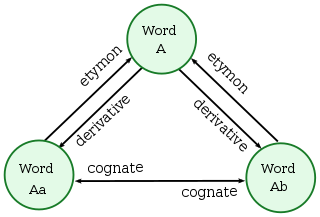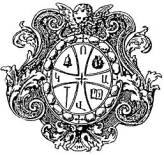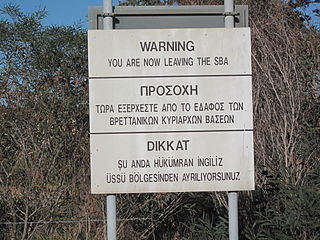
In historical linguistics, cognates or lexical cognates are sets of words that have been inherited in direct descent from an etymological ancestor in a common parent language.

The Levant is an approximate historical geographical term referring to a large area in the Eastern Mediterranean region of West Asia and core territory of the political term Middle East. In its narrowest sense, which is in use today in archaeology and other cultural contexts, it is equivalent to Cyprus and a stretch of land bordering the Mediterranean Sea in western Asia: i.e. the historical region of Syria, which includes present-day Israel, Jordan, Lebanon, Syria, the Palestinian territories and most of Turkey southwest of the middle Euphrates. Its overwhelming characteristic is that it represents the land bridge between Africa and Eurasia. In its widest historical sense, the Levant included all of the Eastern Mediterranean with its islands; that is, it included all of the countries along the Eastern Mediterranean shores, extending from Greece in Southern Europe to Cyrenaica, Eastern Libya in Northern Africa.

Tzatziki, also known as cacık or tarator, is a class of dip, soup, or sauce found in the cuisines of Southeastern Europe and West Asia. It is made of salted strained yogurt or diluted yogurt mixed with cucumbers, garlic, salt, olive oil, red wine vinegar, sometimes with lemon juice, and herbs such as dill, mint, parsley and thyme. It is served as a cold appetiser (meze), a side dish, and as a sauce for souvlaki and gyros sandwiches and other foods.

In archaeology, a tell is an artificial topographical feature, a mound consisting of the accumulated and stratified debris of a succession of consecutive settlements at the same site, the refuse of generations of people who built and inhabited them and natural sediment.

Lavash is a thin flatbread usually leavened, traditionally baked in a tandoor or on a sajj, and common to the cuisines of South Caucasus, West Asia, and the areas surrounding the Caspian Sea. Lavash is one of the most widespread types of bread in Armenia, Azerbaijan, Iran and Turkey. The traditional recipe can be adapted to the modern kitchen by using a griddle or wok instead of the tonir.

Baba ghanoush, also spelled baba ganoush or baba ghanouj, is a Levantine appetizer consisting of finely chopped roasted eggplant, olive oil, lemon juice, various seasonings, and tahini. The eggplant is traditionally baked or broiled over an open flame before peeling, so that the pulp is soft and has a smoky taste. It is a typical meze (starter) of the regional cuisine, often served as a side to a main meal and as a dip for pita bread.

The Levant sparrowhawk is a small bird of prey. It measures 32–38 cm (13–15 in) in length with a wingspan of 65–75 cm (26–30 in). The female is larger than the male, but the difference is not as marked as with Eurasian sparrowhawk. The adult male is blue-grey above, with dark wingtips, and barred reddish below.

The Mechitarists, officially the Benedictine Congregation of the Mechitarists, is an Armenian Catholic monastic order of pontifical right for men founded in 1701 by Mekhitar of Sebaste. Members use the postnominal abbreviation CAM.

Lahmacun, Lahmajun, or Lahmajo, is a Middle Eastern flatbread topped with minced meat, minced vegetables, and herbs including onions, garlic, tomatoes, red peppers, and parsley, flavored with spices such as chili pepper and paprika, then baked. Lahmacun is often wrapped around vegetables, including pickles, tomatoes, peppers, onions, lettuce, parsley, and roasted eggplant.

Armenian bole, also known as bolus armenus or bole armoniac, is an earthy clay, usually red, native to Armenia but also found in other places. The term Armenian was later referred to a specific quality of the clay. Originally used in medication, it has also been used as a pigment, as a poliment or base for gilding, and for other uses. It is red due to the presence of iron oxide; the clay also contains hydrous silicates of aluminum and possibly magnesium.
In pre-modern medicine, the confection of hyacinth had nearly the same virtues with that of alkermes; but, beside that, was frequently used as an astringent. It consisted of nearly triple the number of drugs; of which the precious stone, called hyacinth, was the base. The other chief ingredients were red coral, bole armoniac, terra sigillata, myrrh, the santals, burnt hartshorn, camphor, sapphire, emerald, topaz, uranium, and most of the ingredients of the confection of alkermes.

Manakish, or in singular form man'ousheh, or other spellings, is a popular Levantine food consisting of dough topped with za'atar, cheese, or ground meat. It can be sliced or folded, and it can be served either for breakfast or lunch.

Bole is a shade of reddish brown. The color term derives from Latin bōlus and refers to a kind of soft fine clay whose reddish-brown varieties are used as pigments, and as a coating in panel paintings and frames underneath the paint or gold leaf. Under gold leaf, it "warms" the colour, which can have a greenish shade otherwise. However, bole in art is a good deal more red and less brown than the modern shade; it is often called Armenian bole. Although bole also means the trunk of a tree, these words are simply homographs that do not share an etymological origin.

Syrians are the majority inhabitants of Syria, indigenous to the Levant, who have Arabic, especially its Levantine dialect, as a mother tongue. The cultural and linguistic heritage of the Syrian people is a blend of both indigenous elements and the foreign cultures that have come to rule the land and its people over the course of thousands of years. By the seventh century, most of the inhabitants of the Levant spoke Aramaic. In the centuries after the Muslim conquest of the Levant in 634, Arabic became the dominant language, but a minority of Syrians retained Aramaic (Syriac), which is still spoken in its Eastern and Western dialects.
In pre-modern medicine, diascordium, or diascord, is a kind of electuary, or opiate, first described by Jerome Frascata, and denominated from the dried leaves of scordium, which is an ingredient therein. The other ingredients are red roses, bole armoniac, storax, cinnamon, cassia lignea, dittany, tormentil roots, bistort, gentian, galbanum, amber, terra sigillata, opium, long pepper, ginger, mel rosatum, and malmsey. It was used against malignant fevers, the plague, worms, colic, to promote sleep, and resist putrefaction. In 1746, diascordium was offered in two forms: with or without opium.

The official languages of the Republic of Cyprus are Greek and Turkish. The everyday spoken language (vernacular) of Greek Cypriots is Cypriot Greek, and that of Turkish Cypriots is Cypriot Turkish. For official purposes, the standard languages are used.

The use of medicinal clay in folk medicine goes back to prehistoric times. Indigenous peoples around the world still use clay widely, which is related to geophagy. The first recorded use of medicinal clay goes back to ancient Mesopotamia.

Syria or Sham is a historical region located east of the Mediterranean Sea in West Asia, broadly synonymous with the Levant. Other synonyms are Greater Syria or Syria-Palestine. The region boundaries have changed throughout history. However, in modern times, the term "Syria" alone is used to refer to the Syrian Arab Republic.

The Saint Gregory the Illuminator Church of Galata is the oldest extant Armenian Apostolic church in Istanbul. It was originally built in the late 14th century, in the Genoan period, shortly before the fall of Constantinople to the Ottomans. The church was demolished in 1958 and the current building is a reconstruction from the 1960s.
![]() This article incorporates text from a publication now in the public domain : Chambers, Ephraim, ed. (1728). "Bole". Cyclopædia, or an Universal Dictionary of Arts and Sciences (1st ed.). James and John Knapton, et al.
This article incorporates text from a publication now in the public domain : Chambers, Ephraim, ed. (1728). "Bole". Cyclopædia, or an Universal Dictionary of Arts and Sciences (1st ed.). James and John Knapton, et al.















